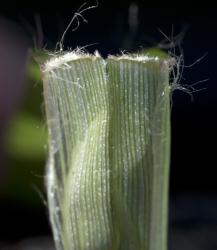- Taxon
- Gallery
- ≡ Cynosurus indicus L., Sp. Pl. 72 (1753)
Compact annual tufts 10–60–(90) cm, shoots at first spreading out very close to the ground, culms later ascending; branching often intravaginal near base. Leaf-sheath coriaceous; margins with a few long, soft hairs near ligule. Ligule 0.3–1 mm, truncate, ciliate. Leaf-blade 6–30 cm × 2–7 mm, usually folded, sometimes flat, coriaceous, often with a few, scattered, long, fine hairs; margins, midrib and subobtuse tip minutely scabrid. Culm 2–50 cm, usually geniculate at base, internodes glabrous. Inflorescence of (1)–2–8–(10) subdigitate spikes, the lowermost ± distant; spikes (1.5)–5–8–(12) cm × 4–6–(8) mm; rachis scabrid on margins, with hairs 0.5–2 mm at base. Spikelets 4.5–6 mm, 3–6-flowered, light green to brownish olive. Glumes < spikelet, membranous, subacute to subobtuse, keel scabrid, thickened, narrowly winged; lower 1.5–2.5 mm, 1-nerved, upper 2–4.5 mm, (3)–5-nerved. Lemma 2.5–5 mm, (1)–3-nerved, subacute to subobtuse, keel thickened, scabrid, with a subsidiary nerve on each side above. Palea 2–3 mm, keels winged. Lodicules 0.4–0.6 mm, membranous, glabrous, nerveless, ± truncate to acutely asymmetrically bilobed. Anthers 0.3–0.9 mm. Caryopsis 1.2–1.5 × 0.7–1 mm, ellipsoid to elliptic-oblong and truncate, red-brown to almost black, obliquely rugose, concave on hilar face; hilum small, basal, round.
[From: Edgar and Connor (2000) Flora of New Zealand. Volume 5 (second printing).]




